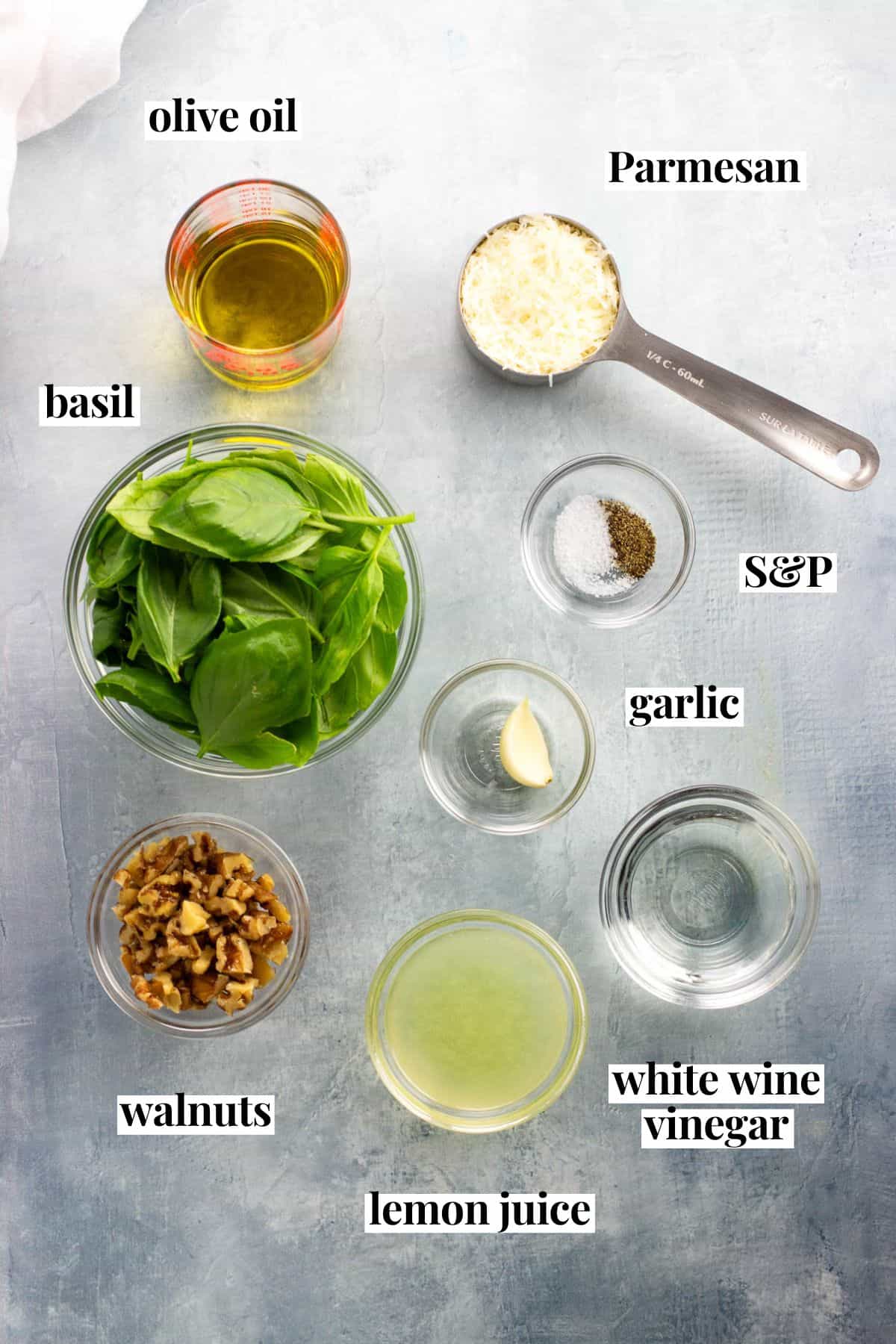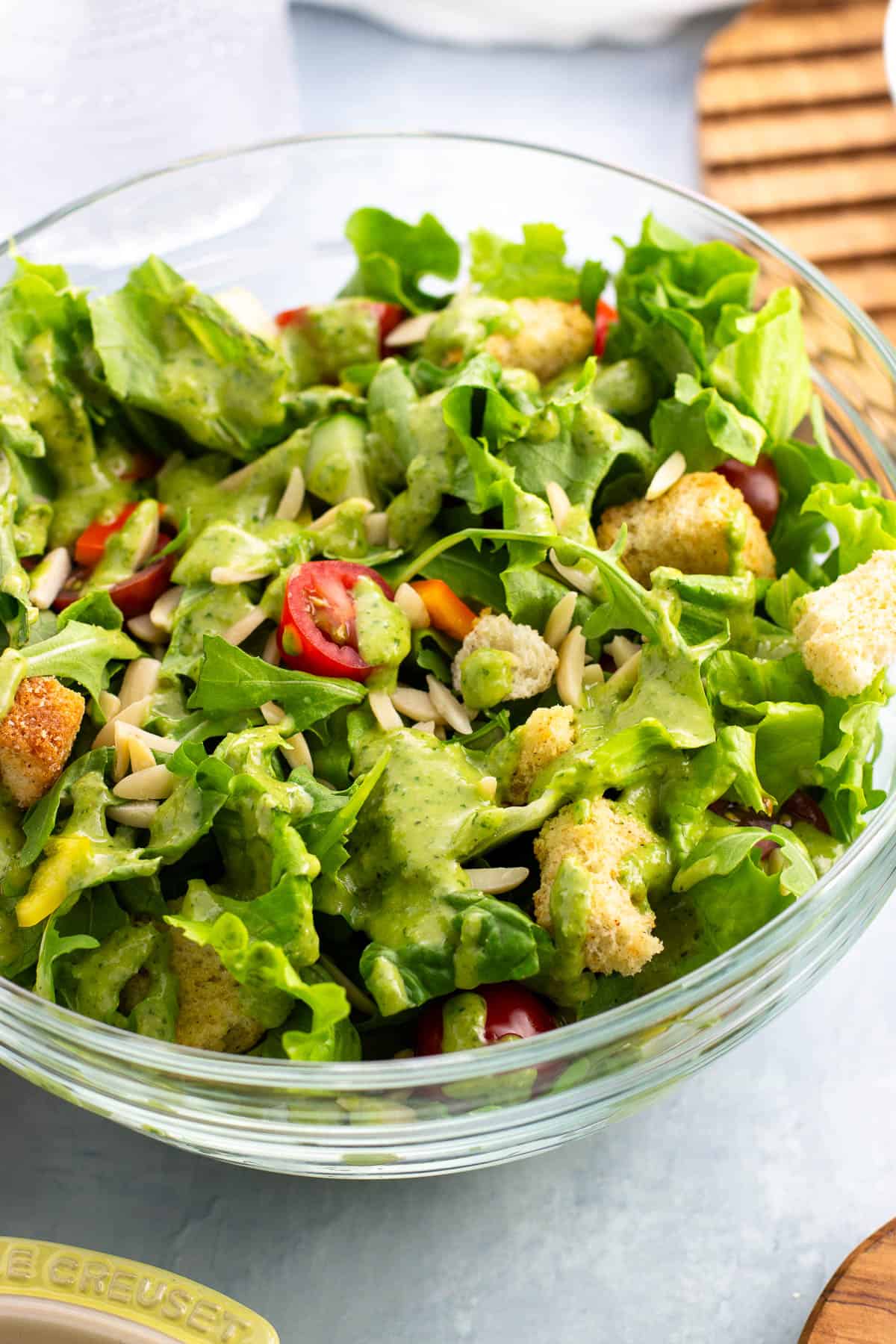This pesto salad dressing features bright, bold flavor to transform even the most basic salad into something you'll crave. With instructions on preparing it from scratch or utilizing a store-bought shortcut, this recipe is creamy while using classic pesto ingredients and stays well in the fridge.

I started off this recipe thinking I would make a pesto vinaigrette, but after adding a little more of this and a little more of that to the food processor, I landed on what I would call a pesto salad dressing instead.
It's fairly thick and achieves a creamy consistency without the addition of mayo or yogurt - just good old classic basil pesto ingredients (plus a little vinegar). If you're concerned a pesto dressing would be like pouring an extra-oily pesto sauce over top of your lettuce, don't be!
Reasons to Love This Recipe
- This pesto salad dressing is perfect for those of us who don't often feel like putting the effort into assembling a salad with a ton of components. A bold dressing brings all the flavor - the rest can be left simple.
- Using both vinegar and lemon juice provides the appropriate punchiness a dressing needs without one flavor becoming too strong. Plus the acidity prevents the vibrant green color from oxidizing and browning.
- It behaves well! It will stay for up to a week refrigerated and I have not had issues with it separating, the oil solidifying once chilled, etc. It stays ready to drizzle.
Recipe Ingredients

- Basil: If buying basil at the store, look for leaves without darkened areas (they will soon be black and slimy). And if the plastic clamshell has trapped condensation, open it up once home and let it sit at room temperature to prevent quicker spoilage.
- Parmesan: A wedge you grate yourself or tubs of pre-grated Parmesan, Parmigiano Reggiano, or Pecorino from the refrigerated deli cases are your best bets here. Shelf-stable canisters just don't hold their weight!
- Walnuts: Typically pine nuts are used in pesto, but they're pricy. I will often substitute in walnuts or almonds interchangeably.
- Garlic: A fresh clove (versus an equivalent amount of jarred minced garlic) is recommended.
- Olive Oil: Extra-virgin olive oil is classic for salad dressings.
- White Wine Vinegar: This has a mellower flavor than plain white vinegar but still brings the sharpness needed for salad dressing. White balsamic vinegar is also a good choice.
- Lemon Juice: Freshly-squeezed provides the brightest touch. This pairs with the vinegar for acidity while providing a complementary flavor.
Step-by-Step Instructions
- Dry ingredients. Add all dry ingredients to a food processor: basil, Parmesan, walnuts, garlic, salt, and pepper.
- Pulse. Pulse until everything is in small, even bits. Stop to carefully scrape down the sides as needed.
- Add the liquid. Pour in half of the olive oil through the spout while the motor is running, then follow with the lemon juice and vinegar.
- Adjust. Check the consistency and add the remaining olive oil if desired.




Recipe Tips and Tricks
- Variations - You can substitute in other greens, such as spinach, baby kale, or arugula, for all or a portion of the basil.
- Other Uses - Beyond salads, this pesto salad dressing can be tossed in a pasta salad, used as a marinade (fat, acid, and flavor!) drizzled over cooked fish, shrimp, and vegetables, stirred into hummus, and more.
- Vinegar/Lemon Juice - For convenience you can likely use all white wine vinegar or all lemon juice, but I haven't tried it this way myself.
- Easy Storage - While this recipe requires a food processor for blitzing, I recommend storing it in a salad dressing shaker bottle. It has a tight seal, is easy to shake up, and features a spout for mess-free drizzling.
- Tasting Note - When tasting this dressing to see if you'd like to add more of anything before serving, keep it mind that the flavor needs to be bolder than you'd prefer than if you were eating it straight-up. It will dilute and become much less sharp once it's eaten over salad greens.

Recipe FAQs
Store this dressing in a covered container in the refrigerator for 4-5 days to a week. With this ratio of ingredients I don't experience any issues with the oil solidifying once refrigerated, but if this happens to you, simply leave the dressing out at room temperature for 20-30 minutes to take the chill off and give it a good stir before serving.
Yes, there is a note in the recipe card on which ingredients to remove if starting with already prepared pesto sauce as a base. Either homemade or store-bought pesto are fine.
While I haven't tried this personally, I think due to the higher oil (fat) content it should freeze okay. Freeze in smaller portions, like the wells of an ice cube tray. Thaw in the fridge and stir it up well before using.

More Pesto Recipes
- Something different - red pesto sauce! Pesto rosso uses a smaller amount of basil, instead relying on sun dried tomatoes to bulk up the sauce. This is SO good on eggs.
- Have you ever though pasta primavera was a little...less than exciting? Me, too. My pesto pasta primavera recipe features roasted vegetables and, of course, pesto for a big boost in flavor.
- Pesto broccoli rice is a fun and different side dish the whole family will love, similar to the concept of cauliflower rice.

Related Recipes
If you’ve enjoyed this recipe, I’d love for you to leave a star rating in the recipe card and/or a comment review below!

Pesto Salad Dressing
Ingredients
- 1 cup fresh basil leaves well-packed
- 6 Tablespoons shredded Parmesan or Pecorino Romano
- 3 Tablespoons walnuts or pine nuts
- 1 clove garlic roughly chopped
- ⅛ teaspoon kosher salt or to taste
- Big pinch ground black pepper or to taste
- ½ cup olive oil divided
- 3 Tablespoons freshly-squeezed lemon juice
- 2 Tablespoons white wine vinegar or white balsamic vinegar
Instructions
- Add basil, Parmesan, walnuts, garlic, salt, and pepper to the bowl of a food processor and process until everything is broken up into small equally-sized bits. Stop to carefully scrape down the sides as needed.
- Slowly pour in ¼ cup of the olive oil as the food processor is running, then the lemon juice and vinegar. Adjust the consistency as desired: add up to the remaining ¼ cup olive oil if you'd like it to be thinner.
Notes
- Yield - This recipe yields roughly 8 ounces (220-ish grams) of dressing in total.
- Storage - Store prepared pesto dressing in an air-tight container in the refrigerator for up to a week. Shake well. If any oil has solidified, leave the dressing out at room temperature for 20 or so minutes before serving.
- Prepared Pesto Substitution - Replace the first 6 ingredients and ¼ cup of the olive oil with ½ cup of prepared basil pesto. Mix in the lemon juice and vinegar, only then adding up to the remaining ¼ cup olive-oil if you'd like a thinner consistency. If the pesto becomes too thin, blend in additional grated Parmesan or nuts.
Nutrition
Nutritional information is provided as an estimate. As it can vary due to many factors (brands used, quantities, etc.), we cannot guarantee its accuracy.
Food Safety and Nutrition DisclaimerWould you like to save this?
Plus receive periodic recipe newsletter emails.






Comments
No Comments